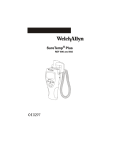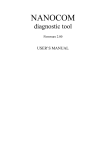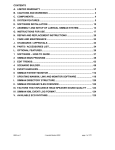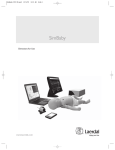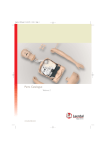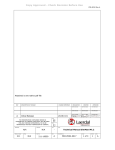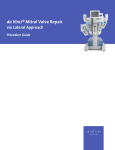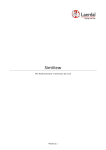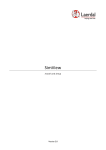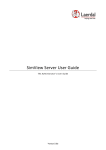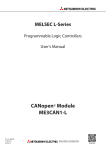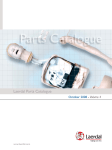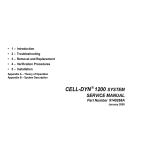Download SimMan Dfu
Transcript
SimMan Directions for Use www.laerdal.com Cautions and Warnings 1. Reorienting or relocating the receiving antenna. 2. Increasing the distance between the device and receiver. 3. Connecting the device to an outlet on a circuit different from that to which the receiver is connected. 4. Consulting the dealer, or an experienced radio/TV technician, for help. Laerdal SimMan should be operated by trained personnel. Do not introduce fluids into the torso area or left (BP) arm of the manikin, as electronic components may become damaged. Clean with mild soap and water. DO NOT SUBMERGE MANIKIN. Latex The veins in the IV Arm, and Pneumothorax bladders contain latex. Users who suffer from latex allergy should take precautions while using or handling the latex parts by wearing non-latex protective gloves. Use on clean surface only. AVOID FELT TIPPED MARKERS, INK PENS, ACETONE, IODINE OR OTHER STAINING MEDICATIONS, AND PLACING THE MANIKIN ON NEWSPRINT OR INKED LINES OF ANY KIND. Students should wash their hands prior to using the simulator and wear gloves when using the simulator. Treat SimMan as you would a real patient. Limited Warranty Use of a defibrillator for training purposes represents an operational hazard equivalent to use of a defibrillator on a real patient since it involves the release of high levels of electrical energy into the training manikin. Consequently: All safety precautions for use of defibrillators must be followed, as if the manikin were a patient. Consult your defibrillator's User Manual. • Defibrillation should be performed on the defibrillation connectors only. If defibrillation is performed over one or more of the ECG connectors, high voltages may be present on the remaining connectors during the shock. • To prevent overheating, do not provide more than three (3) defibrillator discharges (max 360J) in a sequence. Do not exceed an average of two (2) defibrillator discharges per minute during the training session. • The manikin must not be in contact with electrically conducting surfaces or objects during defibrillation. A flame supporting atmosphere, for example with a high content of oxygen, should be avoided during defibrillation. • The manikin chest must be kept dry. Special attention should be taken when using IV Arm, Urinary system or Bleeding Control Modules. • To prevent chest skin electrode pitting, do not apply conductive gel or conductive defibrillation pads intended for patient use. • Do not use cables or connectors having visible damage. • Do not spill fluids over any component inside the manikin torso, since this could damage the unit and might also present a possible hazard for the operator. • If a training session involves the administration of fluids and/or drugs into the IV arm, empty the arm immediately following the training session. • Do not allow the manikin's skin to come in direct contact with ink or photocopied paper, as this can permanently stain the skin. Avoid using colored plastic gloves when handling the manikin, as they may also cause discoloration. • Do not introduce any fluids (except airway lubricant in small amounts to lubricate the airway) into the esophagus or trachea of the manikin. Please refer Laerdal Global Warranty or see www.laerdal.com Approvals: The product is CE-marked and in compliance with essential requirements of council directive 89/336/EEC; EMC – directive. This device generates, uses and possibly radiates radio-frequency energy. If it is not installed and used in accordance with the instructions, it may cause harmful interference to radio communications. In that case, the user is encouraged to attempt correction of the interference by: 2 CAUTIONS AND WARNINGS . . . . . . . . . . . . . . . . . . . . . . . . . .2 INTRODUCTION . . . . . . . . . . . . . . . . . . . . . . . . . . . . . . . . . . . . 3 ITEMS INCLUDED . . . . . . . . . . . . . . . . . . . . . . . . . . . . . . . . . . . . 4 GETTING STARTED . . . . . . . . . . . . . . . . . . . . . . . . . . . . . . . . . . 4 IN USE . . . . . . . . . . . . . . . . . . . . . . . . . . . . . . . . . . . . . . . . . . . . . . 7 MAINTENANCE . . . . . . . . . . . . . . . . . . . . . . . . . . . . . . . . . . . . . 11 TROUBLESHOOTING . . . . . . . . . . . . . . . . . . . . . . . . . . . . . . . . 13 TECHNICAL DATA . . . . . . . . . . . . . . . . . . . . . . . . . . . . . . . . . . 13 PARTS / ACCESSORIES LIST . . . . . . . . . . . . . . . . . . . . . . . . . . . 14 Introduction SimMan is a full body, adult manikin that allows the simulation of Basic and Advanced Life Support Skills and Assessment to develop both individual and team skills. The simulator allows observation and recognition of most vital signs which are used in emergency medicine either directly on the manikin itself or on the included simulated Patient Monitor. When used correctly, these features will support the students’ competence ability to reach the correct diagnosis based on active observation as opposed to being prompted by instructor cues. The patient monitor also doubles as display for other functions, such as display of 12-lead ECG and X-rays. The manikin allows for most relevant medical intervention to be performed according to their medical guidelines and protocols. The Laerdal SimMan contains an advanced airway allowing for simulation of difficult airway management cases. The anatomy can be changed during the scenario (via remote control) to indicate changes to the patient condition or as a response to students’ intervention. Correct form and technique are required to perform direct laryngoscopy and endotracheal intubation. Correct use of a variety of airway adjuncts will successfully ventilate the patient simulator. SimMan is delivered with a set of normal pupils inserted in the head's eye sockets and a separate case containing 3 sets of replacement pupils (normal, constricted, dilated) for simulation of various medical conditions. The simulated patient monitor is a replication of the Philips IntelliVue patient monitor, which includes the ability to set up the screen layout in various ways. It also allows configuration outside the IntelliVue’s features to mimic other patient monitor types as well. SimMan is operated through a Software (SW) which runs on a PC. Interaction with the SW is done through a Graphical User Interface (GUI) where the various vital signs parameters are changed directly or through pre-programmed scenarios. The SW also allows automatic and manual logging of scenario events as well as video capture. The events logged during a scenario can be shown in a debrief viewer together with video capture. The log is synchronized with the video capture. This allows the instructor to review both the log and actual performance during debriefing. The debrief can also be stored for later review. 3 ENGLISH Contents Items included Connection Cables and Tubing (may vary depending upon configuration): - Cable, Link Box to Manikin (15 pin) - Cable, Link Box to PC (9 pin) - Cable for Sounds, PC to Link Box The Laerdal SimMan includes the following main components: - - - - Laerdal SimMan Manikin SimMan Software CD-ROM Directions for Use SpO2 (Pulse Oximetry Probe) Set of Defibrillation Studs: Hands Free Defibrillation/Pacing Adaptors (Heartstart and Physio Control) Plates for Manual Defibrillation Replaceable Neck Skin Collars (6) Roll of Crico-Thyroid Membrane Hy-Tape (2) Chest Tube Insertion Modules (6) Interchangeable pupil set [case containing 3 pairs of pupil inserts (normal, constricted, dilated)] Airway Lubricant Upper Dentures [one (1) non-breakable installed, and (3) breakable] Replaceable Male and Female Genitalia with Urinary Connection Valves Tank Thigh Hardware Kit Tool Kit, consisting of: - Pliers - Screw-driver - Nut Driver - Bolts for attaching optional wound modules to the body Maintenance/Repair Kit, consisting of: - Extra Pneumothorax Bladders - Modeling Wax - Talcum Powder IV Kit, consisting of: - Blood Bags with IV Tubing (2) - Simulated Blood Concentrate Hose, Manikin Air and CO2 Supply Blood Pressure Measuring Kit Track Suit (jacket and trousers) Additional items purchased separately - Pressurized Air and CO2 source (Compressor Unit or Regulator Unit) Getting started To use your SimMan, carefully follow the instructions provided in the “Install Guide” (found in the peripheral box) and this document. Some configurations are delivered with pre-installed software. If your system is not pre-installed, pay close attention to software set-up. Your SimMan will not operate correctly if the software is not properly installed. Attaching the Legs: 1) Remove the belly by pulling gently on the bottom and place it aside. 2) Remove the bag from the leg. 3) Remove the cardboard packing tube from the threaded steel tube protruding from the upper end of the thigh. Caution: Do not allow tape or packing to pull on the wire or air tube extending from the steel tube. 4) Open one Tank Thigh Hardware Kit (1008080) and place the hardware in a convenient spot. 5) Gently feed the electrical wire and plastic air tube through the pelvis hole and into the pelvic cavity. 6) Push the steel tube on the thigh as far as possible through the hole and into the pelvic cavity. DO NOT PULL THE LEG BY THE ELECTRICAL WIRE OR PLASTIC AIR TUBE 7) Slide the flat washer from the hardware kit over the wire, air tube, and steel tube. 8) Slide the spring from the hardware kit over the wire, air tube, and steel tube. 9) Slide the thumb nut from the hardware kit over the electrical wire first, and then over the air tube. 10) Holding the thigh in a convenient position, thread the thumb nut onto the steel shaft until the feel of the hip articulation is satisfactory. 11) Attach the thigh air tube to the open connector on a similar air tube in the pelvis. Right leg tube goes to the tube on the right side, and left goes to left. In addition, some configurations contain the following: - Laptop computer - USB Camera - Simulated Patient Monitor - USB Hub - PDA - Link Box 4 Air and CO2 Source (optional) Option 1: Compressor Unit If you have purchased Laerdal SimMan with a Compressor Unit, attach one end of the double lumen tube into the compressor and the other to the right axillary side of the manikin. Link Box The Link Box connects the manikin to the computer. 1) Attach manikin cable to right lower side of manikin’s torso and to the connector marked “Manikin” on the back of the Link Box. 2) Connect serial cable to connector marked “PC” on the back of the Link Box and to serial port on back of your computer. 3) Connect clear tubing from blood pressure cuff to the inlet marked “BP cuff” on the back of the Link Box. 4) Connect the SpO2 cable to the SpO2 connector on the back of the Link Box. 5) The audio cable has three ends. Connect the RCA / phono plug to the connector marked "Audio input" on the back of the link box. The stereo jack with single wire shall be connected to the Simulated Patient Monitor, and the stereo mini jack with double wire shall be connected to the computer's headphone output. For illustrations please see the accompanying Install Guide. If a wireless microphone is used, the receiver should be connected directly to the Link Box connector marked "Audio input" instead of the audio cable described above (pre-defined vocal sounds will not be possible to use in parallel) 6) Plug the Link Box AC power cable into a power supply (110-240 V AC). If you are using the Portability Kit, attach to the 12 V DC input according to the Portability Kit instructions. 7) Connect external speakers, if used, to connector marked "Ext. speaker" on the back of Link Box. Start procedure: 1) Check that Power switch (4) is set to off position “0”. 2) Plug power supply cable into plug (5) in Compressor panel. 3) Plug power supply cable into power source. 4) Connect CO2 supply to the “Input CO2” connector using the black hosing attached (optional feature). 5) Check that Drain valve (1) is closed. 6) Close Air valve (2) and CO2 valve (3) 7) Push Power switch (4) to on position “1”, the Compressor will start and run for approx. 45 seconds to build up pressure in tank. 8) When Compressor stops, you can start to use the manikin. Open the Air valve (2) and the CO2 valve (3). 9) The Compressor will start and stop with different intervals depending on consumption of air. USB Hub A USB hub is supplied with the system to provide additional USB ports. Connect the USB Hub to one of the USB connectors at the back of the PC. Attach the AC adapter to the USB Hub and to a wall outlet (110 or 230-240V AC). SpO2 Probe The SpO2 finger probe provides enhanced realism for the care provider by simulating the use of an actual pulse oximetry probe. When the probe cable is connected to the Link Box, SpO2 will not be displayed until the probe is placed on one of the manikin’s fingers (means that “light” is blocked). If the probe is not attached to the Link Box, SpO2 will only be displayed automatically when selected by the operator through the instructor panel on the PC. Stop procedure: 1) Push Power switch (4) to off position “0”, the Compressor will stop if it is running. 2) Close Air valve (2) and CO2 valve (3). 3) Open Drain valve (1) and drain air out of system. Blood system The blood system includes a blood bag with tubing that can be connected to the veins and be altered by varying the elevation of the blood bag. Warning: Do not open Compressor box when energized, dangerous voltage inside. Only to be opened by authorized personnel. Important: If the Compressor Unit is stopped manually with the on/off switch, the air tank must be drained before restart. 5 ENGLISH 12) Attach the thigh electrical connector to the open mating connector in the pelvis. Right leg wire goes to the wire on the right side, and left goes to left. 13) Repeat with the other leg. 14) Gently replace the belly. To remove leg(s), reverse the procedure. Option 2: Regulator Unit e) Auscultation sounds - Lung - Heart - Bowel f) Vocal sounds - Numerous vocal sounds are available (moan, vomit, cough, etc.) - Additional sounds can be recorded by the user - Microphone option (instructor may speak directly through the manikin’s head speaker by using a microphone) g) Left/right or bilateral lung obstruction h) Pulse strength i) Activity Log j) Scenario Builder k) Trend Editor l) Event Handler m)Debriefing including activity log synchronized with video and monitor pictures If you have purchased Laerdal SimMan with the Regulator Unit, attach one end of the double lumen tube to the “Air/CO2 out to Manikin” outlet on the regulator and the other to the right axillary side of the manikin. PDA remote control A personal digital assistant or PDA is used as the remote control. The PDA communicates with the software via Bluetooth. A PDA User Guide is included in the peripheral kit. Refer to this guide for additional information. Simulated Patient Monitor The Simulated Patient Monitor is connected to the PC (laptop). It is a touch screen monitor that provides concise clinical feedback of physiological parameters. All parameters are instructor-activated with the ability to set a lower and higher alarm limit for every parameter shown on the monitor. The monitor may be configured to display the desired parameters and curves and it is possible to save and retrieve five (5) configurations. Colors and curve trace speeds can also be changed. The CO2 curve has by default a slower trace speed. Because all information is simulated rather than actual, the parameters, with the exception of ECG, cannot be “measured or displayed” on clinical equipment. For additional information, refer to the software helpfiles. The monitor provides the following output (synchronized with all other clinical outputs) - Arterial blood pressure waveform - CO2 and capnograph waveform - Heart rate related to SpO2 - BP – with timed automatic updating and ‘BP now’ function - Respiratory rate - Blood Temperature - Peripheral Temperature - SpO2 waveform and numerical display with audio output - CVP waveform and numerical display output - PAP and Wedge - TOF - TOF% - CO - inO2 - inN2O - in Anesthetic Agent - etCO2 - etN2O - et Anesthetic Agent - Monitor trends - 12-lead ECG with adjustable ST-elevation and conduction on some rhythms - X-ray Start procedure: 1) Close Air valve (Shut off Air) and CO2 valve (Shut off CO2). 2) Connect Air supply (5-8 bar) to the “Air in” connector using the blue hosing attached. 3) Connect CO2 supply (4-6 bar) to the “CO2 in” connector using the black hosing attached (optional feature). 4) Open Air valve (Shut off Air) and CO2 valve (Shut off CO2). 5) Jet ventilation (TTJV) requires a special connector (available for purchase using part number 381201). Stop procedure: Close Air valve (Shut off Air) and CO2 valve (Shut off CO2). Operating software The SimMan Software serves as the instructor's tool for controlling the training scenario. It requires the following: a) Type; Dell b) Processor: Minimum Pentium M 1,8 GHz or better c) Hard drive: 60 GB minimum d) RAM: 512 MB minimum e) System : Windows XP Pro f) Screen: Dual Screen with min. 1280 x 1024 g) Mouse: Two (2) button scroll wheel mouse h) Other: CD-RW, RS-232 (serial port), 2-4 USB ports, Built-in Ethernet LAN, Internal Bluetooth, Microphone input, Headphone output For software installation, see instructions included in the Install Guide. The software features are: a) Training controls via computer keyboard, mouse and/or PDA b) Extensive ECG library with variable rates and a range of extrasystole types c) Variable pacemaker threshold (external pacemaker training only) d) Control of manikin functions - Airway complications - Tension Pneumothorax - Breathing - BP - NIBP and Arterial - SpO2 simulation - Temperature display 6 - Surgical cricothyroidotomy - Retrograde intubation - Fiberoptic procedures - Light Wand intubation - Bronchoscopy e) The manikin has two lungs. Intubation that is too deep will result in unilateral lung filling. This usually occurs on the right side, due to the accurate anatomical modeling of the tracheobronchial junction and bronchial tree. f) When airway adjuncts are used, ventilation may be made more difficult by activating decreased lung compliance for either the right lung or left lung. Activating decreased lung compliance for both lungs causes airway adjuncts to fail to ventilate. USB Camera The USB Camera provides enhanced debriefing possibilities. Video input is synchronized with the SimMan scenario log. To set-up the camera, see Install Guide and Directions for Use included in your camera packaging. Important: Mouth-to-mouth/nose/mask ventilation should not be performed on SimMan. The upper airways must be thoroughly cleaned and the lungs changed if these techniques are performed on the manikin. Important: Prior to using airway adjuncts, spray the inside of the pharynx, nostrils and all airway management devices to be inserted with a liberal amount of the provided airway lubricant. Important: Connect the camera via a USB port directly on the laptop. Do not use the hub as this may cause interference. Airway Adjuncts – Sizing and Precautions : ET Tubes - While ET tubes as large as 8.5 may be used, we recommend the use of ET tube size 7.5 to extend the life of the simulator. We also recommend the use of a malleable stylette. Care should be taken that the stylette does not extend beyond the end of the tube, as with any direct intubation. Laryngeal Mask Airway (LMA) - The Laerdal SimMan will allow use of the LMA Classic, LMA Unique and LMA Fastrach. Although a #5 LMA may seal correctly, the airway has been designed for use with a #4 LMA. In use Head a) The head allows for performance of head tilt and jaw thrust maneuvers; however, the airway is open in all positions. b) A speaker located in the head allows the instructor to speak through the SimMan (to simulate a patient) or use pre-defined vocal sounds. c) Upper dentures are replaceable. Soft/non-breakable dentures are pre-installed but can be replaced by a rigid/breakable version for more realism. d) To change the pupils: Open the eyelids wide, take care not to rip the face skin. Using the suction cup provided or the edge of your finger nail, remove the pupil from the eye socket. Replace with the pupil of your choice, using the suction cup or press into place with your finger. CombiTube - The Laerdal SimMan will allow the use of the CombiTube, as it will successfully ventilate the “patient”. We recommend the use of the CombiTube trainer, as it will generally withstand multiple uses. The CombiTube trainer is sized the same as a large adult CombiTube. Although a small adult size CombiTube may work with varying success, the CombiTube trainer provides more cost-effective training and reliability of function. Neck a) Bilateral carotid pulses. b) Airway access through simulated crico-thyroid membrane. c) Decreased Cervical Range of Motion - DCROM (instructor-controlled). The instructor can cause any of the ventilation procedure to fail to ventilate by setting both right and left lung “resistance” to “complete”. g) Using the computer user interface or the PDA, the following airway functions may be activated and deactivated: - Laryngospasm - Posterior Pharyngeal swelling - Tongue edema - Trismus - Decreased Cervical Range of Motion - DCROM - Can’t Intubate, Can Ventilate - Can’t Intubate, Can’t Ventilate - Verbal response h) The manikin simulates spontaneous respiration with the following features: - Chest rise and fall - Variable breathing rate - Apnea - Variable pulse oximetry display - Exhalation of air - Exhalation of CO2 (instructor-controlled) - The variable respiratory rate is synchronized to the Simulated Patient Monitor display and lung sounds - The tidal volumes dynamically alter in line with the selected respiratory rate Airway, Lungs and Airway Management a) The airway is instructor-controlled to allow simulation of various airway complications, including the failure of therapeutic airway devices. b) Ventilation can be performed using any of the following: - Bag-Valve-Mask devices - Jet ventilation - Ventilator c) The system does not accept PEEP modes of ventilation. d) SimMan accepts a wide range of airway management devices and techniques. Correct form and technique are required to perform direct laryngoscopy and endotracheal intubation. Correct use of a variety of airway adjuncts will successfully ventilate the patient simulator. Some examples are (see notes below for information on sizing and precautions): - Oral/nasal pharyngeal airways - Endotracheal tubes - nasal and oral - Laryngeal Mask Airways - CombiTube - Needle cricothyroidotomy 7 ENGLISH Calibrating the Patient Monitor Because the Simulated Patient Monitor uses touch-screen technology, it must be calibrated before use. To calibrate the monitor: a) Double click the “elo” logo in the system tray in the lower right corner of the screen. b) Click on the “Align” button in the dialog box. c) If target indicators appear first on the instructor computer screen and not on the patient monitor, press “Esc” or wait until they appear on the patient monitor. d) Touch each target as it appears on the Patient Monitor. e) Touch the green check mark after all targets have been touched. i) Through the operating SW, the instructor can activate respiration complications like: - Pneumothorax - Breath sounds - Decreased right and/or left lung compliance - Stomach Decompression Pulses a) SimMan has physiologically correct palpable pulses: - Bilateral carotid pulse - Bilateral Dorsalis Pedis and Posterior Tibal pulses - Bilateral femoral pulse - Left radial pulse - Left brachial pulse b) The pulses are synchronized to the simulated ECG and, when activated, the external pacemaker upon capture. c) The pulse strength is dependant on the selected blood pressure, but the strength of peripheral pulses can also be manually controlled to simulate a wider range of clinical conditions. d) Pulses, once activated, will remain on for approximately five (5) seconds before reactivation is required. Torso a) Anatomically modeled from a human specimen, the torso demonstrates normal anatomical surface landmarks. b) SimMan has correct anatomical landmarks for external chest compressions. Chest compressions will produce carotid pulses, as well as compression artifacts on the Simulated Patient Monitor. Important: Care should be taken when palpating pulses. Use of excessive force results the inability to feel pulse. Pneumothorax a) Tension pneumothoraces can be simulated through the inflation of resealable bladders. Needle decompression can be performed at: - Bilateral mid-clavicular line, 2nd intercostal space - Right mid-axillary line, 5th intercostal space b) Chest tube insertion can be simulated, and exploration and cut can be made at left mid-axillary line at (4th and) 5th intercostal space. ECG sites c) Manikin is equipped with separate defibrillation and ECG monitoring connectors. The system provides 3-lead ECG readings (4 connectors). Important: We recommend a 22 (or smaller) gauge needle for decompression of the chest. Using a smaller gauge needle increases the longevity of the chest skin and bladders. Caution: The ECG connectors are designed for ECG monitoring only. If defibrillation is attempted over any of the ECG connectors, high voltages may be present on one or more of the uncovered connectors during the shock. (See the "Cautions and Warnings" section.) Defibrillation attempts via the ECG connectors will also damage the internal electronics requiring that they be replaced. The Chest Tube insertion module is located at the left mid-axillary site. This module allows chest tube insertion to be performed. A cut can be made at left mid-axillary line at the (4th and) 5th intercostal space. To replace the used Chest Tube insertion module, simply remove from its location and add a new one with the opening positioned toward the shoulder. Insert Pads a) SimMan contains a left thigh pad, gluteal , gluteal, ventro-gluteal and right deltoid insert pads. b) The pads can be used for intramuscular and subcutaneous injection practice. c) These can be interchanged with optional trauma or nursing wound modules. Defib sites IM/SC Injections The insert pads are foam filled and can be injected with fluids. The foam is removable and should be squeezed out (like a sponge) and allowed to air dry immediately following the practice of these procedures. Powdering foam pads with talcum powder eases reinsertion into the skin. There are four sites for subcutaneous and intramuscular injections, including right deltoid, gluteal, left thigh, and ventro-gluteal. Using a 22 gauge (or smaller) needle increases the longevity of the "skins". d) Manikin is equipped with two defibrillation connectors. ECG signal can also be monitored across these connectors. Instructor can, via appropriate keyboard or remote control, command/select the “Ignore Defib” function. This determines if the defibrillation shock results in conversion to a selected waiting rhythm. Manual paddle adapters are supplied for use with manual defibrillators. Caution: Defibrillation must be performed only over the two defibrillation connectors. (See the "Cautions and Warnings" section.) e) Connectors for external pacing are connected to the manikin’s defibrillation connectors. Patient pads should not be used, as they do not guarantee sufficient contact. The system has a variable pacing threshold and the ability to “ignore” pacing. Pacing capture results in a pulse synchronized with the heart rate and the display of a paced rhythm on the Simulated Patient Monitor. 8 Procedure for filling Blood Bag (IV Bag): Use a syringe to inject fluid into IV bag, and fill to desired level. Control flow of blood into arm, via clamp. Abdominal distension Abdominal distension occurs with excessive ventilation while using Bag-Valve-Mask or if the esophagus is intubated. Urinary catheterization Interchangeable realistic genetalia make it possible to simulate female and male patients. The genetalia is connected to a reservoir which can be filled with liquid during simulated catherization. Air and CO2 Source Compressed air is provided by a compressor or other type of pressurized air source via a regulator unit, allowing many functions to take place: - Airway complications - Spontaneous breathing - Tension pneumothorax inflation - Carotid and pedal pulse Arms Blood Pressure Arm Left Arm is a BP Arm with radial and brachial pulses and Korotkoff sounds. The BP arm allows palpation and auscultation of a blood pressure that can be measured automatically on the Simulated Patient Monitor. Auscultation gap can also be simulated. Operating software The SimMan SW is started by clicking the SimMan icon on the computer desktop. After entry of password (optional) and selecting a profile, the SimMan starts up in the default mode which represents a patient in a healthy state. If the web camera recording is enabled, you will be prompted to start the recording. For more information on this feature, refer to the section on video recording later in this document or to the help files. The operating software is controlled via a Graphical User Interface (GUI). The GUI displays an overview of the current status of simulated patient’s vital signs, the control functions for modifying these, and a time-based log of the events which has occurred during the scenario. Blood pressure settings are controlled using the computer or remote control. These settings are also linked to the ECG functionality, so if you are changing the rhythm from a perfusing rhythm to a non-perfusing rhythm, this will also be reflected on the blood pressure settings, which will be changed according to the new type of rhythm. A non-perfusing rhythm will also change breathing rate (BR) to zero. When changing to a perfusing rhythm, the blood pressure will remain at 0/0 until changed; breathing rate can not be changed until blood pressure has been established. The patient simulator can be operated in three manners; - Manual mode, - Semi-automatic mode - Automatic mode IV-Arm Right Arm is a Multi-venous IV Arm allowing: - Cannulation - Phlebotomy - Drug administration - Infusion The veins are self-sealing allowing multiple uses; however, repetitive insertions in the same area will result in leakage sooner than if the cannulations had been spread over a wider area. The venous system and the skin sleeve are both replaceable. Operating Modes Manual mode In manual mode the vital signs parameters are changed directly through changing the values one-by-one based on the desired change of the patient condition. The various vital signs parameter can be changed directly on the GUI in the following ways. For detailed description, please see help files under “Help” in GUI’s Program Menu Bar. - To change values in the “Instructor Monitor Control Center” (upper right corner of the GUI); click on the parameter and set the new values, or rotate the mouse wheel while the cursor is over the numerical values. - To change values in the “Airway and Circulatory Control Center” (center section which includes a torso illustration), by click directly on the parameter which is to be changed and select the new state, or use the slider bars. - To change values in the “Respiratory Control Center” and “Difficult Airway Control Center” (upper left corner) select state or use the slider bars. The IV arm can be used with simulated blood by attaching the supplied IV bag tubing to one of the two latex vein openings near the top of the arm. Using the supplied simulated blood concentrate, mix the desired volume of simulated blood and add to the IV bag (see procedure below). Release simulated blood until it runs via the tubing into the arm and out the other latex vein. Once fluid is running freely out of the second vein, seal it using a clamp. Using a 22 gauge (or smaller) needle for IV training increases the life of the IV arm skin. If you want the student to infuse medicines, attach a second IV bag for free flow. 9 ENGLISH Sounds The torso contains a number of hidden speakers that allow the realistic auscultation of sounds: - Lung - Heart - Bowel Semi-automatic / Automatic mode In Semi automatic / Automatic mode the change to multiple vital signs parameter can be pre-defined as “trends”. These trends can then be activated one-by-one directly or multiple activated via the “event handler” function. Trends allow the instructor to introduce physiologic situations into the simulation. A brief overview is shown below, for more information refer to the help files. To create a new scenario: 1. Choose “Start Scenario Editor” from the Edit dropdown menu. 2. Click the new scenario () button The scenario is constructed from a set of frames. Each frame represents a state of the patient. The scenario can only operate in a single frame at any given time. The scenario moves to other frames as events specified in the “Events field” occur. To control which frame the scenario moves to, connection lines are drawn from each event box to the desired frame. When the specified event occurs, the scenario moves to the corresponding frame. For a more detailed description, refer to the software help files. To use pre-programmed or saved trends: 1. Select the “Start/Stop…” button located in the Trends box in the main window. 2. Select the desired trend. 3. Click the start button. Saving Scenarios To save a new scenario: 1. Select “File” from the dropdown menu. 2. Select "Save". 3. Enter the name of the scenario. 4. Click the “Save” button. To build and save new trends: 1. Select “Start Trend Editor” from the Edit dropdown menu. 2. Select the parameter to be included in the physiologic model of the trend you wish to design. 3. Click “ok”. To retrieve the file at a later time: 1. Click the “Start Scenario” button on the GUI. 2. Select your saved scenario. Automatic mode, creating and using scenarios In automatic mode, scenarios which includes multiple alternative and consecutive changes to the vital signs can be pre-defined. The scenarios can be constructed so that the change from one condition to the next may have multiple outcomes. The various outcome alternatives have been defined in the scenario and triggered by pre-defined events. These events may be either automatically registered events such as “time” or a defibrillator shock, or by manually entered events such as administration of drugs. Debriefing during or after a scenario The debriefing function is available both during and after scenarios. To activate the debrief view, click on the “Debrief” button. If you are currently running a scenario, this action will automatically pause your running scenario and take you to the debrief screen. After you have reviewed the log, you can choose to save the debrief or return to the scenario without saving. To exit, select “Exit” from the file dropdown menu and follow the prompts to save or exit without saving as desired. If you paused a running scenario, click on the play ( ) button from the main SimMan GUI to resume the simulation. For more information on the Debrief viewer, refer to the help files. SimMan is delivered with a set of pre-programmed scenarios. Pre-programmed or saved scenarios can be started, paused, halted or debriefed from the “Scenario Control Center” found in the lower left quadrant of the GUI. Halting the scenario When a scenario is running, clicking the halt ( ) symbol will put the scenario is manual mode. The software will confirm that you want to stop the scenario. After a “yes” response the word “Halted” will appear on the screen. The scenario continues to run but all operations must be carried out manually by the instructor. To fully stop and save a scenario, click the debrief button. When the debrief viewer appears, choose “Save As” from the “File” dropdown menu. To start a scenario: 1. Click “Start Scenario”. 2. Select a simulation case to run. To temporarily halt the scenario, click on the pause (II) symbol. To resume a simulation that has been paused, click on the play ( ) symbol. To halt a scenario, click on the halt ( ) symbol. Instructor Monitor Control Centre The instructor can manipulate the values of the monitor parameters from the Instructor Monitor Control Centre which can be found in the upper right quadrant of the main GUI. Adjustments can be made to any of the physiologic values by pointing the mouse over the desired area and clicking. Windows will open allowing the instructor to select and apply the desired changes and functions. Before creating a new scenario, it is important to understand the difference between Events and Actions. Events Things that happen outside of a scenario, usually caused by students, are called “Events.” The ABC/Miscellaneous/Medication events in the main window are also called “Scenario Events.” There are also “Time Events” caused by either of the two timers reaching a predetermined limit Configuring the Patient Monitor and Simulator and Creating Profiles General configurations for both the simulator manikin and patient monitor can be controlled via the GUI. To configure: 1. Select “Configure” from the “Edit” dropdown menu. 2. Select either the “General” or “Patient Monitor” tab. 3. Double click on the appropriate icon to enter submenus. 4. Make desired changes. 5. Select “ok” to initiate the change. If you have changed the configuration, the software will ask you whether or not you wish to save the changed configuration, try it without saving or cancel the operation. If you choose “yes,” you will Actions In a scenario, “Actions” are performed by the scenario. For example, changing a parameter value, creating an airway complication and making vocal sounds are “Actions” performed by scenarios. 10 - Clean with mild soap and water. DO NOT SUBMERGE MANIKIN. - Modules and all other parts should be drained and air-dried thoroughly prior to storage. Disinfectants should be used when appropriate. - All subcutaneous and intramuscular injection pads should be squeezed to eliminate excess water. To prevent mildew and mold, the foam filling should be soaked in a mild solution of bleach and water or a 1% Virkon solution. Squeeze the solution out and allow the filling to air dry prior to reinsertion and storage. - Articulating parts will benefit from a light application of talcum powder prior to training sessions. - Powdering inside of chest skin with talcum powder decreases “plastic sound”. - Air filter in compressor should be replaced every two years. Directions for replacement are part of the Technical/Service manual. - A Technical/Service manual is available for purchase using part number 211-19550. - A general inspection should be conducted regularly. Do not use the product if cables or tubings have signs of damage. - Store properly between teaching sessions. If stored in hard cases disconnect cables and tubings and remove legs. The different parts should be correctly positioned before closing the cases. Edit the Patient Monitor Set-Up from the GUI The patient monitor can be edited to replicate different healthcare institutes and clinical environments thus increasing realism during scenarios. To access the patient monitor set-up: 1. Open the “Edit” dropdown menu. 2. Select “Edit Monitor Set-up…”. A window will open showing the standard patient monitor configurations. Refer to the help files for a detailed description of the different configurations. Choose Monitor Set-Up Using View The patient and the instructor monitor can be individually configured. Click on “View” to show the dropdown menu. The default settings shows “Instructor = Monitor” checked, indicating both displays are the same. If different settings are required, uncheck “Instructor Monitor - Patient Monitor” To select the desired monitor configuration: 1. Click “view”. 2. Select “Patient Monitor Setup…” or “Instructor’s Monitor Set-up” from the view dropdown menu. 3. Select the desired monitor configuration and click “open” to activate the new configuration. Tension Pneumothorax Decompression–Bilateral Mid-Clavicular Sites To repair (vulcanizing/contact cement is needed): 1) Remove skin at shoulder sides, mid-clavicular, and remove bladder from site cavity. 2) Cover the surface of the pneumo bladder with vulcanizing/contact cement (not included). Avoid getting contact cement on chest plate. 3) Allow to air dry completely. 4) Replace bladder and chest skin over torso and secure skin at the shoulders and both sides. 5) Fill puncture marks on exterior of chest skin with modeling wax, supplied with manikin, by applying firmly with fingertip while stretching skin. Video recordings SimMan utilizes a webcam for recording the students’ performance during a scenario. For a complete debriefing experience, the recordings can be integrated into the debriefing guide. To set-up the camera for video recording, follow the instructions provided in the “Install Guide.” Be sure to note that the camera should be connected directly to a USB port on the back of the laptop. Do not use the hub as this may cause interference. Select the “Video Recording Configuration” from the “Edit” dropdown menu then make your selections and press “ok”. Note: Video will be stored on the hard drive of the instructor’s computer. PDA remote control The PDA comes pre-installed with some SimMan configurations. If your PDA is pre-installed, turn the PDA on and select the SimMan Pocket icon from the Programs menu to start the PDA application. To replace: 1) Remove skin at torso sides. 2) Lift the chest plate exposing its underside. If your PDA has not been pre-installed, refer to the SimMan/ SimBaby PDA User Guide (located in the peripheral kit) for complete installation instructions. 3) Disconnect bladder hose from in line hose connector. 11 ENGLISH Maintenance be asked to name the new profile you created. A space is provided for additional comments. To open a saved profile, follow the steps shown above to open the configuration window then select “Open profile.” 4) Remove bladder from site cavity by pulling it from top side of chest plate. supplied with manikin, by applying firmly with fingertip while stretching skin. Chest Drain - Left Mid-Axillary Site To replace chest tube insertion module: 1) Remove skin at torso side and left shoulder. 2) Remove chest tube insertion module from mid-axillary side of manikin. 5) Insert new pneumo bladder into site cavity and reconnect to the inline hose connector by threading it through from top side of chest plate. 6) Replace chest plate. 7) Replace chest skin over torso and secure skin at the shoulders and both sides. 8) Fill puncture marks on exterior of the chest skin with modeling wax, supplied with manikin, by applying firmly with fingertip while stretching skin. 3) Insert new chest drain module. 4) Replace chest skin over torso and secure skin at the shoulders and both sides. Tension Pneumothorax Decompression - Right Mid-Axillary Site To repair (vulcanizing/contact cement is needed): 1) Remove skin at torso side. 2) Remove flesh colored box from mid-axillary side of manikin. 3) Remove pneumo bladder from the box. 4) Cover surface of pneumo bladder with vulcanizing/ contact cement (not included). 5) Allow to air dry completely. 6) Fold bladder and replace in box, return box to torso. 7) Replace chest skin over torso and secure skin at the shoulders and both sides. 8) Fill puncture marks on exterior of chest skin with modeling wax, supplied with manikin, by applying firmly with fingertip while stretching skin. Breathing Bladder To replace bladder: 1) Remove skin at torso sides. 2) Lift out the chest plate. 3) Fold the lungs upward. 4) Remove foam part. 5) Disconnect bladder tubing from nipple on manifold-block. 6) Connect new bladder to same nipple. 7) Replace foam, lungs and chest plate. 8) Replace chest skin over torso and secure skin at the shoulders and both sides. To replace: 1) Remove skin at torso side. 2) Remove flesh colored box from mid-axillary side of manikin. Crico-Thyroid Membrane Hy-Tape 1) Expose neck to visualize opening that has been molded in place of crico-thyroid membrane. 2) Remove used Hy-Tape from opening. 3) Cut a 4cm (1") strip of Crico-Thyroid Membrane Hy-Tape and apply it over the opening to create simulated membrane. 4) A tight seal will enhance actual feel and sound of crico-thyroid membrane penetration. 3) Remove pneumo bladder from box. 4) Disconnect bladder hose from in line hose connector. Neck Skin Collar 1) Lay a neck skin collar, with dull side out, into molded track around neck area of trainer, and attach collar ends together. 5) Remove bladder from site cavity. 6) Insert new pneumo bladder into site cavity and reconnect to in line hose connector. 7) Fold bladder and replace in box, return box to torso. 8) Replace chest skin over torso and secure skin at the shoulders and both sides. 9) Fill puncture marks on exterior of chest skin with modeling wax, 2) The collar is designed to provide multiple sites for needle and surgical techniques. When a fresh site is needed, rotate the collar. 12 ENGLISH IV Arm When excessive leaking occurs at the puncture sites, a new vein and skin should be installed to reduce loss of fluid. Ideally, the skin and veins should be replaced near a sink. To remove the arm: Remove deltoid pad from arm. Disconnect the attachment hardware arm using a screwdriver. 1) If replacing both skin and veins, cut skin off and discard. The thumb will detach with the skin (new skins come standard with thumb installed). 2) If the skin is not damaged and you wish to reuse it, lubricate inside of skin with liquid detergent. Beginning at the top of the arm, roll the skin down and off arm and hand. 3) Remove old veins and discard. 4) Use acetone or equivalent to remove spots of old glue from vein grooves. Dry and swab grooves with alcohol. Place new veins along grooves, extending both veins beyond arm at least 10cm (4”) allowing room for connections. Spot glue veins as needed. We recommend using “Vynabond” or “VLP” from PDI (Plasti Dip International), “PL 400” from Tremco or an equivalent. To replace skin: 1) Roll top of skin down to the hand. Spread liquid detergent generously over lower part of the arm. Holding skin and arm with palms upward slide hand into skin, working the skin over the fingers as with a glove. Then, roll the skin up the arm. 2) Reattach arm when finished. Troubleshooting Refer to www.laerdal.com for more information. Technical data The product is CE-marked and in compliance with essential requirements of council directive 89/336/EEC; EMC – directive. 13 200-03050 Pupils set 38 11 02 Fastener for Neck Skin (pkg. 10) 211-10050 00 38 11 Assy Head Head Assy, without bronchial branches 211-10150 01 38 11Skin Head Head Skin, with airway 38 11 06 Teeth Upper Rigid (polyester) 200-00250 Cricothyroid Membrane Tape (1 roll) 38 11 07 Teeth Upper Soft (vinyl) 38 11 05 Neck Skin (pkg. 6) 211-10250 Airway Complete 38 31 10 Chest Tube Insertion Modules (pkg. 6) 38 02 00 Arm Assy, blood pressure 38 07 00 IV arm, right 38 02 10 Cuff Assy, Blood Pressure 1005162 Thigh pads, set of 2 300-00150 Thigh Pad (1) 211-11050 Leg assy right w/ 38 06pulses 50 pedal Leg Assy Plain, right 38 06 00 Leg Assy Plain, left 38 04 10 Post set, ECG/defibrillation 211-12050 Leg assy left w/ pedal pulses 38 04 55 Chest skin with chest drain 38 04 61 Kit Adult Female Genitialia w/valves 31 20 29 Skin & Vein, IV arm 38 04 62 Kit Adult Male Genitialia w/valves 14 38 08 10 Pad Set, Shoulder and Hip 211-15350 380420 211-15250 38 04 05 Bladder Assy Mid-Clavicular (Pneumothorax Chest) 38 04 06 Bladder Set Mid-Axilliary (Pneumothorax Side) 380446 380460 380470 380471 380475 380480 252090 245-16750 300-00750 Power-cord (US) Power-cord (EUR) Power-cord (UK) Link box Jacket Trousers Directions for Use Hardware set, arms to torso Chest plate assy and shaft G2005 Lung Shaft, compression G2005 Foam in chest Genitalia blank Belly plate assy Plug, belly plate Pin, pelvis Thrust assy cpl. Airway Lubricant 180 ml Audio cable Blood concentrate 4 Oz Accessories 210-01050 210-01150 381220 381655 245-18050 211-19550 38 13 00 Pulse O38 xim13 etr00 y Probe Pulse Oximeter Probe 381850 211-20050 38 04 35 Breathing Bladder 211-25050 381550 210-00550 245-16350 Cable Assy, Manikin-Link Box (15 pin D-sub) 38 10 10 Tubing Assy, Compressor-Manikin, Air/CO2 27 15 00 Cable to Link Boxto Link Box CablePC PC/Monitor (9(9pin pinD-sub) D-sub) 15 Compressor 230-240V Compressor 110V Regulator unit Carrying case, manikin Transportation case, peripherals Technical Service manual Portability kit SimMan Nursing Wound Module set SimMan Trauma Module set Bleeding control module set Forced air bleeding system w/wounds ENGLISH NOT ILLUSTRATED 260305 260306 260307 380100 380901 380902 211-19050 380201 © 2006 Laerdal Medical AS. All rights reserved Printed in US N0207 rev E
















